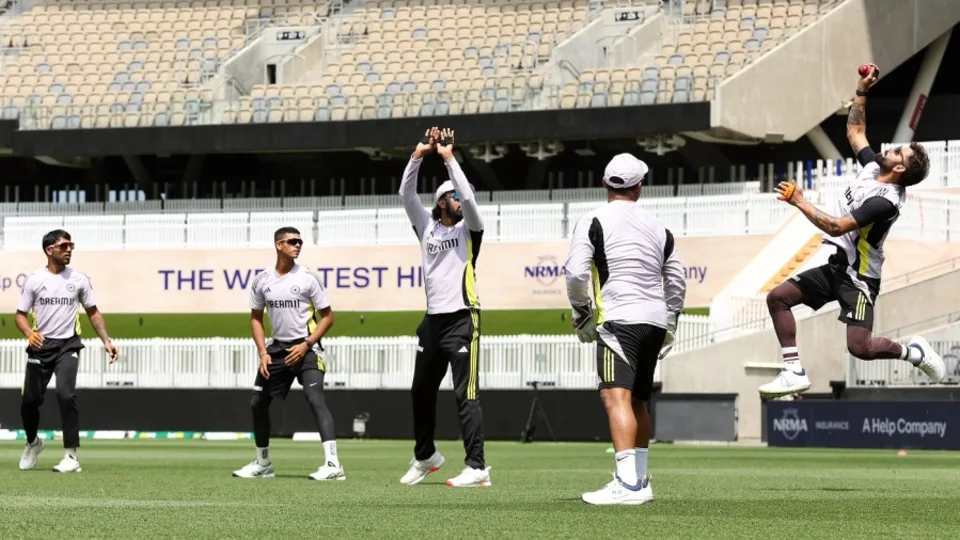
India’s likely 11 gathering a lot of interest ahead of Perth test with Rahul, Padikkal, and Jurel expected to be involved.
India’s likely 11 has been a topic of discourse for the better part of the last week. We might finally have an indication of what it might look like.
Those who can provide pace and bounce with the ball and fight it with the bat may be included in India’s starting lineup for the first Test of the Border-Gavaskar Trophy, which starts here on Friday. Under these circumstances, KL Rahul is expected to reclaim his position at the top of the order, Devdutt Padikkal is probably going to be at number three, and Dhruv Jurel is almost guaranteed to be at number six.
Two players who are naturally on the defensive, Rohit Sharma and Shubman Gill, would have been on a full-strength squad. With the India captain recently becoming a father once more and the No. 3 sustaining a hand injury, this team will be missing them.
It shouldn’t be too difficult to fill the opening post. For starters, India had Rahul, who has experience in the role, and they knew Rohit might not make it. Rahul kept himself occupied in the nets on Tuesday, concentrating on his defence and shouting aloud when his attempts at certain things failed.
Gill suffered an unanticipated and last-minute injury while fielding. India had to adjust quickly, and they did so by asking Padikkal, who was with their A team in Australia, to remain. On Tuesday morning, Padikkal batted with the first group. In batting-friendly conditions, which these are not, his height and reach may provide a challenge to bowling attacks by making good-length balls suddenly drivable.
Another top order batsman in India’s lineup has amassed a tonne of runs in domestic cricket, but he has struggled to get over his initial reaction of being uneasy against the increased bounce and pace these surfaces provide. Abhimanyu Easwaran only had the opportunity to bat with the bowlers in the nets. He probably won’t be playing in the Test match in two days.
There is still one position available in the middle order since Kohli and Pant are locked in at Nos. 4 and 5, respectively.
A slip catch that came hard and fast at Sarfaraz Khan went through his fingers, causing the greatest noises of the day, first laughter and then some geeing up. The sound of Jurel’s bat descending to meet the ball was the second loudest. Their days couldn’t have been more dissimilar for the two athletes vying for the sixth position.
Sarfaraz stood on the edge. In reality, he was only at slip when Rahul and Yashasvi Jaiswal left it to practise tight catching to the spinner. This is also where Jurel’s day started, at third slip. Jurel really came into his own as the squad moved from the main field into the nets. With his bat face down and his gentle hands. He rose up on tiptoe and continued to rise balls down like a pro. Letting them drop dead in front of him. At the other end of the range, he also played a stunning flick stroke to a fast ball. His twin fifties performance in Melbourne, his decision-making. And the amount of time he had to get right behind the ball in Perth earlier this month could very well have launched him into the XI on Friday.
Whether it was standing where the umpire would be or accompanying Reddy back to the top of his mark, India’s bowling coach Morne Morkel spent the majority of his time tending to Nitish Kumar Reddy. He doesn’t have the pace, but he has the run-up of a fast bowler. He attempted to hold a line outside off stump and pin the hitter to the crease in an effort to make up for that.
Reddy might rotate the frontline quicks more effectively if he could complete 6–10 overs per day without giving up too many runs.
Given that three of Australia’s main hitters—Usman Khawaja, Travis Head, and Alex Carey—are left-handers. Ashwin will most likely get the spin bowling berth in India’s likely 11. Despite not bowling in the nets at Optus Stadium, Ravindra Jadeja managed to finish a lengthy batting session.
Harshit Rana’s work in match simulation situations at the WACA has given him some impetus. A large portion of that time was devoted bowling into the wicket and attempting to catch his opponents off guard. He is twenty-two. He’s powerful. He lacks a great deal of first-class experience. However, he has been making an impression on the right people, and that is frequently more significant than mere statistics. On Tuesday, Rana didn’t bowl a lot at the nets.
The clay of the Optus Stadium surface is identical to that of the WACA. It will provide bounce and pace, but it must first bake in the sun. This wasn’t available on Tuesday since rain forced Australia to postpone their practice session. India’s likely 11 has had to look past the inexperience of some of their players—Jural, Reddy, Rana, Prasidh, and Padikkal have only played seven Test matches between them—and consider their potential in order to adjust their XI to those conditions.

